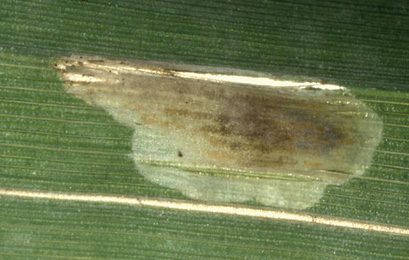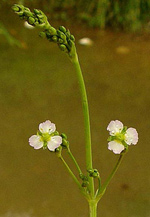|
||||||
|
ALISMA. Water-plantains. [Alismataceae] |
|
|
Three species and one hybrid of Alisma are recorded in Britain. These include Ribbon-leaved Water-plantain (A. gramineum), Narrow-leaved Water-plantain (A. lanceolatum) and Water-plantain (A. plantago-aquatica). All are native species. The BSBI provide a downloadable plant crib for Alisma and Luronium, Baldella and Alisma. Ribbon-leaved Water-plantain is protected under Schedule 8 of the Wildlife and Countryside Act, 1981. Six British miners are recorded on Alisma. A key to the European miners recorded on Alisma is provided in Bladmineerders van Europa. |
|
|
Key for the identification of the known mines of British |
|
1# > ? Leaf-miner: Details of mine unknown. |
|
|
Hydrellia meigeni Zatwarnicki, 1988 [Ephydridae]. |
|
1a > Leaf-miner: A number of short, rather broad corridors that enter the blade from the midrib. Pupation within the mine, mainly in the leaf base and the midrib. At the moment only adult flies can be separated from H. stratiotae.. |
|
|
Hydrellia mutata (Zetterstedt, 1846) [Diptera: Ephydridae]. |
|
1b > Leaf-miner: Irregular mine, locally shallow, elsewhere much deeper, giving it a mottled appearance. In broadleaved plants the mine often begins as a blotch with stellate extensions, but sometimes as a very fine, shallow corridor. In grasses the mine often begins in the leaf sheath. The frass is very fine-grained, initially scattered, later in aggregates. The egg is deposited on the plant surface, and the empty egg shell remains visible. But the larvae are able to leave their mine and restart elsewhere, thus mines without an egg shell can be found as well. The larva also leaves the mine before pupation. Pupation takes place in a newly made, small, blotch mine without frass; this mine may be made in another plant (species). |
 Mine of Hydrellia griseola on Glyceria fluitans Image: © Willem Ellis (Bladmineerders van Europa) |
|
|
Hydrellia griseola (Fallén, 1813) [Diptera: Ephydridae]. |
1c > Leaf-miner:Shallow upper-surface mine that enters the blade from the petiole. Pupation internal, often in midrib or petiole. |
|
Hydrellia flavicornis (Fallén, 1823) [Diptera: Ephydridae]. |
|
1d > Leaf-miner: A short, irregular, linear upper surface mine on any part of the leaf. Also recorded from young pods (Bland, 1997a). Long corridor mine. As a rule the first part of the mine is lower-surface, the later part upper-surface. Often the loops are so dense that a secondary blotch is the result. Because upper- and lower-surface corridor segments often cross, the mine obtains a strange array of transparant patches. There is no association with the midrib. Frass in strings and thread fragments. Pupation outside the mine; exit slit in upper epidermis. Mine not associated with the veins or midrib of the leaf (It is this character which enables distinction from another Agromyzid pest species - Liriomyza huidobriensis). The larvae may leave one leaf (if not large enough) and enter another leaf, via the petiole). It exits the leaf to pupate through a semi-circular slit in the upper surface of the leaf. |
|
|
Liriomyza bryoniae (Kaltenbach, 1858) [Diptera: Agromyzidae]. |
|
1e > Leaf-miner: The mine starts with a broad corridor. Later a broad blotch, not determined by heavy veins. The mine is full depth and very transparent. The colour in the end is reddish-brown, making mined plants very conspicuous, even from a distance. Frass irregular. Often several larvae in a mine. |
|
|
Bagous alismatis (Marsham, 1802) [Coleoptera: Curculionidae]. |
|
|
||
| Last updated 30-Jun-2019 Brian Pitkin | ||
|
|
||

